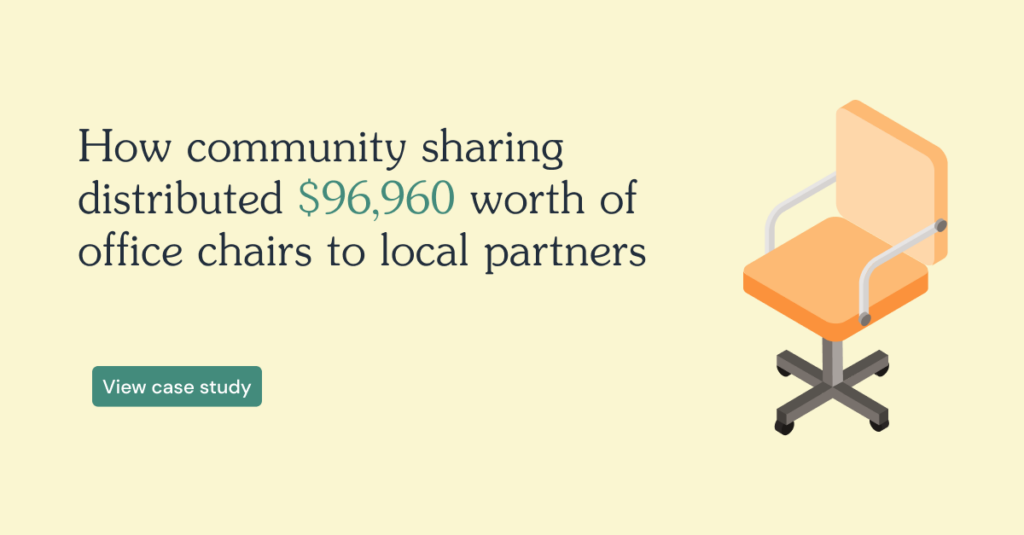Surplus Asset Management
Rheaply puts reuse on the table for every organization.
Surplus asset management
A surplus asset is any item that a company no longer needs, such as office furniture, equipment, or vehicles. These assets can accumulate over time and take up valuable space, leading to increased storage and maintenance costs. Surplus asset management refers to the practice of managing and disposing of excess or unused assets in a responsible and cost-effective manner. Effective and sustainable surplus asset management is a crucial principle for companies looking to reduce costs and optimize their operations.
To address asset surplus issues, companies can implement a surplus property program or a surplus asset management solution, which involves identifying and managing unneeded assets as efficiently as possible. Surplus management strategies may include surplus buying, which involves purchasing surplus assets from other organizations at a discounted price, or surplus selling, which involves selling surplus assets to generate revenue.
By implementing a surplus asset management program, companies can benefit from reduced procurement costs, increased operational efficiency, and enhanced sustainability efforts. Additionally, diverting waste from landfills and other disposal sites helps companies to enhance their corporate social responsibility efforts. For example, a company may choose to repurpose or recycle surplus assets rather than disposing of them in landfills, leading to reduced waste and a lower environmental impact. This can also help companies comply with various regulatory requirements related to waste management and environmental sustainability.
Examples of surplus assets may include office furniture and equipment, vehicles, machinery, and electronic devices. These assets may become unneeded due to a variety of reasons such as business downsizing, technological upgrades, or changes in production processes. Overall, effective surplus asset management is a win-win situation for businesses, as it not only increases profitability but also promotes responsible and sustainable business practices.
Surplus marketplace
To manage surplus assets effectively, organizations like enterprise businesses, manufacturers, governments, healthcare providers, and construction companies should consider implementing surplus management systems. These systems can help identify, track, and manage surplus assets across an organization, enabling stakeholders to make informed decisions about how to best handle the excess.
One option is to use a surplus marketplace, which connects organizations with surplus assets to those in need of those assets. This can help businesses sell or donate surplus assets more easily and reduce storage and maintenance costs. Additionally, surplus marketplaces can help organizations find and purchase high-quality used assets at a lower cost than buying new ones.
Another option for surplus management is to partner with a surplus management company. These companies specialize in helping organizations manage and dispose of surplus assets, and can provide services such as asset appraisal, marketing, and disposal. This can be particularly useful for larger organizations or those with a high volume of surplus assets.
Effective surplus management is essential for businesses that want to reduce costs, optimize their operations, and enhance their sustainability efforts. By implementing a surplus management system, utilizing surplus marketplaces, or partnering with a surplus management company, organizations can maximize the value of their surplus assets while minimizing waste and environmental impact.

What is surplus management?
Surplus asset management, also known as surplus management, refers to the process of identifying, tracking, and managing surplus materials and assets within an organization. This process offers several benefits that can help organizations optimize their operations, reduce costs, promote sustainability, and contribute to more equitable communities.
- Operational efficiency – One of the primary benefits of surplus management is operational efficiency. By maintaining an organized inventory of their assets, organizations can easily identify available resources and allocate them efficiently. This can lead to increased productivity, streamlined operations, and a more effective use of resources.
- Cost efficiency – Surplus management helps organizations reduce the costs associated with storage, maintenance, and disposal of surplus materials and assets. By selling or repurposing surplus assets, organizations can generate additional revenue and reduce expenses. Additionally, surplus management can provide opportunities for organizations to purchase or sell assets at a lower cost, generating savings and increasing profitability.
- Sustainability – Surplus management promotes responsible and sustainable business practices by diverting waste from landfills and reducing the need for new resources. By repurposing, recycling, or donating surplus assets, organizations can contribute to a more sustainable economy.
- Equity – Surplus management can also help promote equity within communities by facilitating the donation or sale of surplus assets to non-profit organizations, schools, or other institutions that may have limited resources.
Surplus asset management is a critical component of effective resource management. By properly managing their surplus materials and assets, organizations can improve operational efficiency, reduce costs, promote sustainability, and contribute to more equitable communities.
Surplus management services
At Rheaply, we provide surplus asset management services to organizations through our resource management platform, which helps organizations like yours identify the value of your existing assets and reduce the environmental footprint of unused items. We also offer comprehensive consulting and field services to help you establish a circular economy roadmap for your organization’s resources and to ensure your Rheaply platform launch is a success. Our sustainability consulting service is designed to solve operational challenges and enhance overall sustainability by helping organizations develop strategies that drive better visibility, utilization, and exchange of your organization’s resources.
Surplus management software
Surplus management software is a type of technology that helps organizations track, manage, and dispose of surplus assets such as office furniture, fixtures, and equipment. This software is designed to streamline the surplus management process, making it easier and more efficient for organizations to manage their assets.
Surplus property software typically includes features such as asset tracking, inventory management, and reporting. These features allow organizations to track the status of their assets, including their location, condition, and value. This information can be used to identify surplus assets and determine the best course of action for managing them.
Surplus management software can also facilitate the process of selling or repurposing surplus assets. The software can be used to list surplus assets for sale, track offers and bids, and manage the transaction process. Additionally, surplus management software can help organizations identify potential buyers or recipients for surplus assets, such as non-profit organizations, schools, or other institutions.
One of the primary benefits of surplus management software is increased efficiency. By automating many of the tasks associated with surplus management, organizations can save time and reduce costs. For example, asset tracking and inventory management can be performed more quickly and accurately with the use of software, allowing organizations to identify and manage surplus assets more efficiently.
Another benefit of surplus management software is improved accuracy and transparency. By maintaining a digital record of surplus assets, organizations can ensure that their data is accurate and up to date. Additionally, surplus management software can provide detailed reporting on the status and value of surplus assets, making it easier for organizations to make informed decisions about how to manage their assets.
Surplus management software is a valuable tool for organizations looking to manage their surplus assets more effectively. By providing features such as asset tracking, inventory management, and reporting, surplus management software can increase efficiency, improve accuracy, and facilitate the process of selling or repurposing surplus assets.
Building asset management
Building asset management is the process of managing and maintaining the physical assets of a building or property. Building asset management software can be used to facilitate this process by providing tools for tracking, analyzing, and maintaining these assets. A key aspect of building asset management is sustainability, which involves minimizing the environmental impact of building operations while maximizing efficiency and cost-effectiveness.
One important sustainability strategy in building asset management is the adoption of a circular economy model. A circular economy is an economic system that prioritizes the repurposing, sharing, and recycling of resources to reduce waste and promote sustainability. This can be applied to building assets by promoting the sharing and repurposing of materials, equipment, and fixtures. Here are some ways in which a circular economy can be integrated into building asset management:
- Lifecycle Assessment – Sustainability in building asset management involves considering the entire lifecycle of a building and its assets. This includes factors such as material sourcing, construction processes, and end-of-life disposal. Building asset management software can help track the lifecycle of assets and identify areas for improvement.
- Asset Sharing – By sharing assets within and between buildings, building owners and managers can reduce the need for new purchases and promote more efficient use of resources. Asset inventory management software can help track available assets and identify opportunities for sharing.
- Repurposing Assets – Instead of disposing of assets when they are no longer needed, they can be repurposed for new uses within the building or donated to other organizations. Building asset management software can help track the lifecycle of assets and identify opportunities for repurposing.
- Recyclable Materials – Building asset management can also prioritize the use of recyclable materials in construction and renovation projects. This can reduce waste and promote a circular economy by ensuring that materials can be repurposed or recycled at the end of their useful life.
In conclusion, building asset management is an important process for ensuring the sustainability of building operations. By using asset inventory management software and building asset management software, building owners and managers can identify opportunities for sharing and repurposing assets to promote a circular economy. By implementing sustainability strategies and circular economy principles, building asset management can help reduce environmental impact and promote long-term cost savings.


